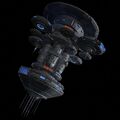Guardian Class
More actions
The Guardian-class spacedock is currently the largest class of space stations in operation by the United Federation of Planets. Combining successful design features from both the Spacedock-class family and the Regula-class family, this massive station has multiple large docking facilities, the capability to handle modular additions, and some of the most potent defensive armaments in Starfleet service.
While the Spacedock-class stations were being upgraded continually over the previous hundred and thirty years, they could not fully take advantage of new technologies that would require massive overhauls to their spaceframe, which led to a mismatch of technology types. These stations have become gradually less and less integrated. Starfleet developed the Guardian-class station as an evolutionary replacement to the Spacedock-class, given that a ground-up new redesign would be able to utilize late 24th-century technology fully in a way that simply upgrading the older design piecemeal had not.
Guardian-class stations remain very rare, though Starfleet plans to replace many important Spacedock-class stations within the next fifty years.
Description
Like all spacedock-type stations, the Guardian-class is a large, multi-purpose station with the ability to manage the logistics needs of an entire sector. They are equipped for starship construction, repair, and resupply, large-scale trade and cargo operations, scientific inquiry, command and control functions, and are powerful defensive platforms, all while serving as a home to tens of thousands of residents. A spacedock of any class is a massive investment by Starfleet and the Federation, requiring many years to build and tens of thousands of crewmembers, so they are only ever built in the most strategically important locations in the Federation. Guardian-class stations specifically are reserved for the most critical sites.
Layout
Guardian-class stations are divided into four major sections: the upper spacedock, the lower spacedock, the hub, and the central core which connects them. Passing through all four sections is the travel core, with both standard turbolifts for journeys of less than a hundred decks and larger two-story trams for longer trips. In addition, this class of station is equipped with point-to-point transporters, which allow for instantaneous travel between several fixed locations within the station.
Upper Spacedock
The upper spacedock is very similar to the one found on the original Spacedock-class, but with much larger doors. It is a large, round module in the shape of a mushroom cap with four space doors leading into a cavernous docking facility. Directly above the bay is the station's main arboretum, as well as living quarters, diplomatic areas, and administrative facilities. Beneath the bay are further living quarters and engineering support facilities.
Hub
The hub serves as the anchor point for the medium-sized modules that are attached to the station approximately one-third the way down its height. The hub itself is home to the majority of the station's civilian population and the twin promenade levels. The center of this module has large cargo bays and attachment points for additional modules. Eight tactical modules which contain the station's primary shield generators are mounted above and below the hub in every configuration of the station. The default configuration for the rest of the modules is two large docking modules and two medium modules attached to the hub, with a total of four science or medical modules attached to the bridges that join the hub to the docking modules.
Central Core
Connecting the hub to the spacedocks above and below it, the core is largely concealed by four enormous deuterium tanks for refueling starships. Fuel tankers can dock directly at four refueling points connected to the tanks. These refueling modules also contain redundant shield generators to protect the volatile hydrogen fuel stored there. The core itself contains overflow crew accommodation and accommodations for visiting personnel and other short-term residents. Directly beneath the upper spacedock and above the lower spacedock are two identical reactor modules attached to the central core.
Lower Spacedock
The lower spacedock is based on the design of stations in the Regula-class family, with two open bays on either side of a roughly conical module. These two bays are intended for turn-around traffic and handle short-term stays for vessels too large to utilize the smaller bays around the hub. This module also has a large number of crew quarters and cargo bays, as well as the station's primary communications and long-range sensor array.
Engineering
Guardian-class stations incorporate some of the most sophisticated technologies developed by Starfleet, with cutting-edge designs at every level of the station's operations.
The reactor modules are very distinctive on the Guardian class, directly below the upper spacedock and above the lower spacedock. They each glow with four sets of four massive impulse engines fed by two fusion reactors each, giving the station the ability to hold position even in challenging gravitational currents. These modules also contain two enormous matter/antimatter reactors, which provide main power for the station. Between each of the impulse quads is a large deflector dish, which functions in a very similar way to those on starships: they keep the space lanes around the station clear of debris and help focus long-range sensor scans.
Numerous antennae extend from various positions on the station, with long-range communications handled through the massive spires on the bottom of the station and short and medium-range communications through the spires on the docking modules near the center of the station. Typically, a station of this class serves as a hub for the Subspace Relay Network, and it processes hundreds of thousands of messages every day.
Computer systems aboard the Guardian are fully bioneural in the primary cores with redundant isolinear backups for engineering and defensive systems. Every compartment on the station has holographic projectors, and the majority of the interfaces are holographic.
Docking & Cargo Facilities
Spacedock-type stations are designed to be able to service an entire fleet at the same time, and as such the Guardian-class can comfortably accommodate 40 starships of mixed sizes in internal bays, with a further 42 external docking ports for shorter visits. Compared to a Spacedock-class station, the Guardian-class improves efficiency dramatically with the use of external docking ports and many bays without cumbersome space doors.
The upper spacedock is intended for long-term stays for maintenance and the construction of new starships, where the radiation shielding properties of the space doors are most useful. This bay contains berths around the central tower for sixteen explorer-type starships or a larger number of smaller ones, with four massive space doors that give even the Odyssey-class more than enough clearance. At the floor of the bay, there are a further four construction bays that can each build or refit two cruiser-type starships simultaneously. The bay is ringed by twelve cargo bays that have their own smaller space doors, each one above an extendable docking port. Above the bay are four runabout pads, and beneath it are eight large shuttle bays.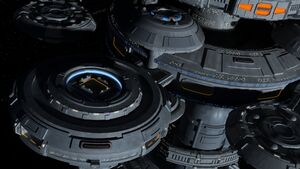
Turnaround Starfleet traffic is handled in the lower docking bay, with enough space in the central open docks to handle four explorer-type starships or a much larger number of smaller ones, with ships stopping here to exchange crew, refuel, or other tasks that only require a few hours to accomplish. The smallest starships can also be accommodated in six docking bays that ring the exterior of this module, while cargo traffic is routed to two massive freight bays above it.
Between all of these facilities, a Guardian-class station supports its own fleet of thirty-two runabouts and a hundred shuttles. In addition to these standard craft, this class of base can also support four squadrons of sixteen fighters.
Defensive Capabilities
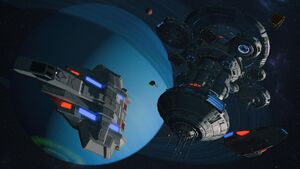
Guardian-class stations, as their name suggests, are potently defensive installations. They will guard the most strategically important locations in the Federation, as more units come online. 66 specially-designed Type-XIV phaser arrays dot the surface of the station, providing comprehensive phaser coverage. These arrays are among the largest weapons in current service, with substantially increased firepower over the Type-XII arrays found on most front-line starships. In addition to these phaser arrays, 28 burst-fire torpedo turrets are located in strategic areas: protecting both of the main docking modules and the shield generators. The shields themselves are projected from eight tactical modules near the center of the station, with secondary generators located in every module, which gives the station's shield profile an incredibly complex interlocking pattern of bubbles. This increases redundancy and makes it more difficult for enemies to weaken them.
One of this station's most effective defensive assets has nothing to do with its firepower: a combination sensor and communications system that can provide real-time scans of their whole solar system at once, which allows them to keep tabs on every single vessel under their influence. It's just as hard to sneak up on one of these fortresses as it is to assault one.
Population & Stationboard Life
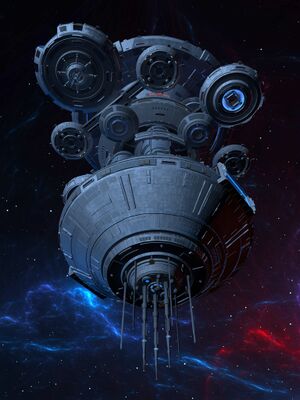
Though this class of station has a maximum total population of 200,000, a Guardian-class station has a standard Starfleet crew complement of 60,000 and a resident count of around 40,000. The exact population varies on where the station is located. For example, Starbase 38 over Barzan II has a much larger civilian population because Barzan II is only inhabitable by the native Barzans due to a toxic atmosphere, while Starbase Bravo over the idyllic colony of Mellstoxx III has a comparatively low civilian population because of its proximity to a habitable world.
Living quarters are very spacious for both Starfleet and civilian residents, with even the most junior crewmen getting at least their own rooms. While the central column of the station provides overflow quarters, the vast majority of accommodations are located above and below the two spacedocks and in the station's central habitat module, which connects to the four smaller docking bay complexes and serves as the station's commercial hub. The station's two promenades are located above and below the cargo levels around the circumference of that module. They both contain lounges, shops, restaurants, bars, and other leisure facilities spread across five decks. These stations typically have a mix of privately-run businesses and Starfleet-run options with holographic staff. In addition, there are two hundred holodecks, four hundred holosuites, and a large assortment of sporting courts, gymnasia, and other such spaces.
Greenspace is provided near the top of the station, in an arboretum located directly above the primary docking bay. Unlike Spacedock-class stations, which have an actual dome, the arboretum aboard a Guardian-class station is partially simulated through holographic projections, with the base of the arboretum being 'real' but only about ten decks worth of curvature built into the station's structure and the remainder of the dome an illusion. This both saves space while retaining this important feature. The resulting parkland has trees and plants from almost every member world and is suitable for formal events as well as recreation. An amphitheater is present here, as well as a number of smaller structures and plazas. In addition to their decorative value, the plants provide oxygen.
Medical facilities are state-of-the-art, with two hospital modules located just off of the habitat module. These facilities provide two thousand patient beds each, in addition to a number of infirmaries spread throughout the rest of the station to handle day-to-day procedures and care. The hospital modules are identical to the two science modules, and each has two docking ports to receive patients directly from hospital ships.
History
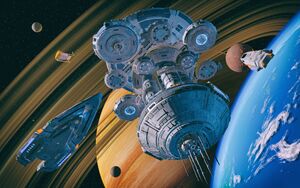
By the late 2370s, it was clear that the aging Spacedock-class was approaching the limit of its ability to be upgraded with new technology, especially after the explosion of innovation spurred on by the Dominion War. Defensive technologies were especially difficult to just bolt onto an existing space frame without major re-working of the design. Starfleet Command authorized the Starfleet Corps of Engineers to develop a new class of spacedock to take full advantage of new technologies, with the goal of a more modular design that could last for the next hundred and fifty years at the least. Dubbed the Guardian-class, these stations would replace the oldest Spacedocks and be used to protect the most strategically-important places in the Federation.
Twelve Guardian-class stations were ordered in 2380, with Starbase 185 over Ciatella VIIb the first to finish construction near Romulan space in 2390, where it served as a major check against the chaos that resulted from the destabilization of the Romulan Star Empire. Other notable Guardian-class stations include Starbase 38 (known as Guardian Station) and Starbase 4, which were both constructed in the 2390s. Starfleet plans on replacing all Spacedock-class stations in due course, but the Guardian-class remains very rare by 2399.
Gallery
Guardian-class spacedocks In-Play
- We know from Star Trek: Discovery that the original Earth Spacedock was under construction at least as early as 2257, which makes that design over 150 years old by 2399. It's likely that this design was continually upgraded in the intervening century and a half, but there's only so much you can do without radically altering a design to accommodate new technology. That's what the Guardian-class is for. It does exactly the same thing a Spacedock-class station does but with all of the new technologies invented since 2257 baked into the actual design and not tacked on piece by piece.
- These stations are nothing at all like Deep Space 9: they are massive cities in space that also happen to be shipyards and impregnable fortresses. That's why they're only in very important locations and why they're not available for player fictions.
- Still rare by 2399, these bases will impress your characters, even if they're familiar with stations like Earth Spacedock.


